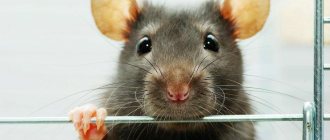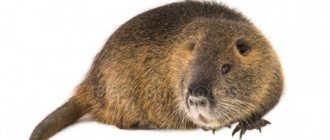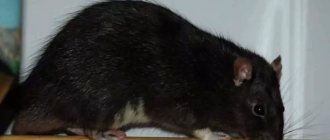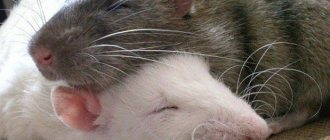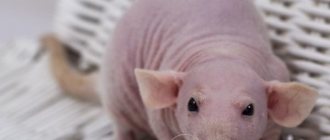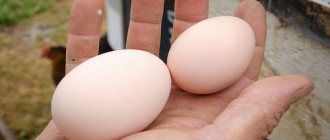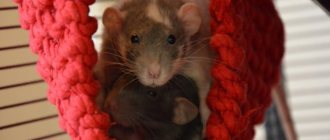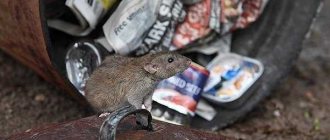Care and maintenance at home
Caring for tame animals is not difficult.
They take up very little space, and caring for dambos does not require any expense. To ensure a comfortable existence for pets, you should take into account some features of the life of eared babies. Dumbo rats are inquisitive and intelligent. They are superior in intelligence to hamsters and guinea pigs. They waddle like penguins. Their physique does not allow them to run fast, but the animals take walks and mark their territory.
Owners need to take into account that while traveling around the house, rodents will taste everything they come across on the way. Walks must be supervised; animals spend most of their time in cage houses.
Housing for one pet can measure 60 cm in width, length and height. An open aquarium is not suitable, as animals can get out of it. High jumping half a meter is not a record for them. A wire cage with a plastic tray and shelves will be especially cozy if you put a house in it for a relaxing holiday.
Rodents love to be alone and feel protected. The bottom is covered with wood filler; sometimes napkins are spread underneath for ease of cleaning. It is preferable to use shavings, not sawdust, which enter the animal's respiratory tract.
Hanging cups and nipple drinkers must be installed at a sufficient level taking into account the size of the pet. Dry and liquid food are placed in different bowls. A separate corner is allocated for a tray with filler. They won’t let your pet get bored and provide daily loads of stairs, a hammock, and a tunnel.
It is recommended to install the cage with your pet on a small hill up to 1 m from the floor. It is better to choose a place away from bright light and radiation sources
It is important to provide protection from drafts, loud sounds, overheating or hypothermia
The temperature comfortable for pets should be about 20°C, air humidity 50% or more. On hot days, spraying the home or a container of water near the cage helps combat dryness, which is harmful to the breathing of rat pups.
To ensure full life support for pets, several rat pups are bred. Same-sex individuals will not be bored; opposite-sex individuals will bear offspring.
The cage is cleaned as needed, 1-2 times a week. The appearance of an unpleasant odor is a signal to disinfect the home. Removing food residues and replacing litter will help maintain the sanitary condition of the home, which affects the pet’s well-being.
Dumbo rats carry out hygienic procedures independently - they wash themselves and clean their fur. Help is required in regularly shortening growing claws. It is recommended to occasionally bathe pets in heated water. For the fur you need a special shampoo from the pet store.
The Dumbo rat does not like the intrusive attention of household members; communication with other pets should be limited. At the same time, it is a social animal, capable of appreciating communication with humans, becoming attached to its owner, and showing boundless trust in those who show it care and affection.
Training in the form of a game brings joy to the animal, which can learn to find a treat, overcome barriers, and fetch objects. Weasel makes the little rat a loyal and affectionate companion.
Habitats
In cities, rats' habitats are closely related to humans. They are usually found in basements and on the first floors of buildings. If there are large numbers of rats, they can also penetrate the upper floors, right up to the attic. In the warm season, animals often settle in earthen burrows in open areas: in gardens, parks, lawns and other places. With the onset of cold weather, rats return to buildings. However, the pasyuk is not distributed everywhere, but only in those areas of the terrain that meet its main requirement: the presence of sufficient water and food. If there is a lack of food, the rat can move up to 3 km from the nest in search of it. To gain entry into the premises, the rat uses any destruction around technical communications inputs, faulty windows, doors and hatches. Indoors, rats move along walls or shelters. Sometimes they can travel through sewer pipes, emerging from the toilet and returning through it back to the basement.
Rats are mainly animals with a nocturnal and crepuscular type of activity. During daylight hours, they lead a secretive lifestyle, staying in their shelters or other shelters. The life of a gray rat is connected with its home, in which it not only finds protection from predators and adverse influences of the external environment, but it also serves it for feeding its offspring. Basically, rats prefer to dig holes in the ground at a depth of 50-60 cm, and the total length of one rat hole can reach 2-5 meters. Sometimes rats live in nests located directly among bags of various products, in various voids, under awnings, in construction waste, etc.
Rats can live in the same buildings without moving into neighboring ones. Relocation can only be associated with the destruction of a building or its major repairs. At the same time, they scatter not far away (300-400 m) and hide in neighboring (often unfinished) buildings. But if necessary, they can move several kilometers, which contributes to their wide distribution. As a rule, pasyuki live in small families, groups or clans of 5-15 individuals. Each group occupies its own area of territory (approximately 40-50 sq. m), within which the animals find all the necessary conditions for existence: food, water, shelter. The boundaries of the rat's area are marked with urine. On it the rats create travel paths, underground passages, and shelters. The number of rats in residential buildings, just like in other buildings, undergoes regular seasonal changes, increasing in the spring due to the mass emergence of young animals and in the fall - due to the arrival of young animals from spring litters, as well as individuals of other groups.
Types and breeds of decorative rats
There are different types of pet rats that, when handled correctly, become tame. Depending on the type of coat, animals are standard, satin, curly, or sphinx. The average weight of adult males is from 400 to 650 grams, and females - 250-450 grams.
Pet rats
Standard
Domestic standard breed rats are characterized by a proportional build. They are slender and agile animals. At the top of the head there are small, proportional ears. The entire body of the rodent has shiny fur that adheres to the skin. The hair on the legs and tail is short.
Light-colored animals have velvety fur on their ears. There are whiskers above the eyes and on the cheeks. If the rodent has a different type of fur, the whiskers may be short and curled. Decorative rats of the Standard breed are one of the largest rodents, weighing up to 500 grams.
Dumbo
Rats of this breed differ in the structure of their skull. The ears are round in shape and located in the middle part of the head, which is slightly flattened.
Dumbo breed
Dumbo animals have completely open ears. In some individuals they are slightly bent at the edges. Some specimens have a slightly protruding nape. From behind, the animal has an extended body shape.
Rex
Rex are animals that have curly and hard hair. There are short curling antennae on the cheeks.
The Double Rex species of decorative rats appears in parents with curly fur. The skin of such animals is dotted with areas of hard guard hair or down. Shedding is a feature of the breed. After birth, the pet loses its fur and bald spots appear in patches. After this, the fur grows, and in those places where it was, it falls out.
For your information! This species has no official name.
Sphinx
This is a type of domestic rat that has no fur at all. In some cases, there is a small fluff in the groin area, paws and head. Rodents have pink skin with visible folds. Some individuals have black spots on their skin.
Sphynx breed
Satin
Satin animals have thin and shiny fur. The attractiveness of rodents is ensured by the shine of their fur coat. Some satin pets have short hair, like standard animals.
Tailless
The animal has a telling name. His tail is completely missing. The body has a pear-shaped shape, which distinguishes the animals from other species. Animals without a tail are active and intelligent. Rodents have curly or standard coats of different colors. Some individuals have no hair at all.
Tailless rat
Manx
Manx rats are characterized by the absence of a tail, which is why they are classified as disabled rats. Most of these animals have diseases of the urinary system and hind legs. The fur of the animals is straight or curly, the color is different.
Other breeds of decorative rats
Among the interesting breeds of decorative pets are the fuzz. In appearance they are similar to sphinxes. There is only fluff on the skin, and there are no guard hairs. Long-haired rats are similar in appearance to standard rats, but have a longer coat.
Habits and habitats
In central Russia there are mainly two types of rats: black and gray.
Black rat
Black rat, or roofing, attic, ship rat. The coloring of “black” rats is very diverse - from pure black, black-brown with graying to reddish, reddish-gray, typically pasyukov coloring and ashy. Young animals are more uniformly colored than adults. Black rats are smaller in size than gray ones, but large old animals, especially from pigsties, can reach 350–380 g. This is a heat-loving species of tropical origin. It climbs very well, in nature it often leads a semi-arboreal lifestyle, it swims reluctantly and rarely. Active mainly at night.
Black rats live in groups that include adults of both sexes and young animals. Hierarchical relationships are established within the group with dominance of one male. Two or three females usually dominate the rest of the group with the exception of the eldest male. Black rats are less aggressive than pasyuki; females are more aggressive than males. In case of danger, they try to hide from their pursuer and only, when caught, use their teeth. Over the past 100 years, the black rat's habitat has been dramatically reduced and fragmented. It is believed that the black rat is being replaced by the more prolific and hardy beaver.
Gray rat
So, the most common rat in our country is the gray rat; it is also called the barn rat, the red rat, or the pasyuk. This is the largest and most vicious of the rats living among us. In places where they live together, where they compete for food and shelter, the gray rat always wins and displaces the black one. The gray rat is strong, cunning, unusually daring and dexterous, lives in cities, villages, residential buildings (usually in basements), warehouses, fields, gardeners' gardens, and even lives in forests. You can see it at a railway station, as well as at a pier; a favorable environment for its habitat is also a garbage dump and the surrounding area; they like to live near food waste dumps, that is, gray rats live wherever there is food. In addition to plants, rats happily eat meat products and feed on garbage. They also eat the corpses of animals and the bodies of dead people left unattended. And one of the reasons for sitting near the deceased (so that he is not left alone) is rooted precisely in this circumstance. This is explained by the fact that rats are very attracted to the fresh smell of corpses. Rats also attack completely living creatures: young chickens, geese, piglets, puppies, ducks, in a word, all small animals that cannot defend themselves, including helpless little human cubs.
Appearance of the rat, description and characteristics
The body of the rat is oval-shaped and stocky. The body of the animal is from 8 cm to 30 cm, weighing up to 500 g, there are small ones weighing 37 grams.
The eyes and ears are small, the muzzle is sharp and elongated. Is the tail longer than the size of the rat's body, hairless or covered with fine hair? invisible to the human eye (a type of black rat has a tail with a thick coat of fur). There is a species of short-tailed rodents in the world.
A rat's teeth are arranged tightly together in rows and are designed for chewing food. These animals are omnivores; they differ from other predators in the absence of fangs and diastema - this is an area on the gums where there are no teeth.
There are no dental roots, so growth occurs continuously throughout the rat's life. For convenience, they need to constantly grind down their teeth, otherwise she will not be able to close her mouth.
The teeth are strong with hard yellow enamel, which makes it possible to easily chew through concrete, cement and hard various metals.
The rodent's body is covered with a thick, dense coat of guard hairs. The color range is varied, gray with different shades of dark or light, red, orange and even yellow.
Rats are very active and agile animals, running 17 km a day and jumping up to 1 meter in height. They swim well, are not afraid of water and can catch fish.
Rats often turn their heads in different directions because they have a small viewing angle and see the world around them in gray tones.
Hearing functions perfectly, rats distinguish sounds with a frequency of up to 40 kHz (humans up to 20 kHz).
Life expectancy is from 1 year to 3 years. In laboratory conditions, rats can live 2 times longer.
Silvered colors
Silver can be any of the recognized colors, both solid and ticked. A distinctive feature of the colors of this section is the alternation of silver and colored hairs in equal quantities. Each silver hair should be as white as possible, although a colored tip is acceptable. Silver colors should give an overall impression of sparkle and shine. If there are a few white hairs interspersed, the color is not considered silver. The silveriness must be clearly expressed so that the silver color cannot be confused with pearl (Pearl) or any homogeneous (Self).
The belly color of silver agoutis and cinnamons should be judged according to the standard of homogeneous agoutis and cinnamons, but in a lighter variation. The belly color of other silver varieties should be consistent with the color as a whole.
Silvered Black
Dark charcoal color, as black as possible, with even interspersed silver hairs throughout the body. The eyes are black.
Silvered Blue
Gray-blue color with silvery-white hairs evenly distributed throughout the body. The undercoat is light bluish to almost white (as light an undercoat as possible is preferred). The eyes are black.
Silvered Mink
Smooth gray-brown color with a blue tint. The number of silvery and non-silvery hairs is equal. Each silver hair should be as white (or creamy silver-white) as possible, although a colored tip is acceptable. The eyes are black.
Description and classification
The taxonomy of the rat places it in the class of mammals, the order of rodents, and the family of mice. Most species have a body size of up to 30 cm and a weight of 30-400 g. The largest rats can exceed this size. They lead a terrestrial lifestyle, some can climb trees, live in burrows alone or in family groups, almost all species are omnivores. Therefore, to the question whether a rat is an animal or not, the answer will only be in the affirmative.
On the territory of Russia, only 3 types of rats live in nature: gray, black and Turkestan. Many species of rats are common in various regions of Asia, America, and Australia. Tree rats live in the forests of North America, the palm rat, which lives on palm trees, is ubiquitous on the Pacific Islands, the Himalayan species lives in China and Vietnam, etc.
In addition to wild rats, there are also domestic species. Breeders have developed many breeds of ornamental rats, which are popular among rodent lovers. Among them you can find animals with and without curly hair, with a flat tail, with fluffy or tailless ones, with large ears, etc. – see photos of rat species.
Types of rats
When asked what color rats are, the answer is that the coat color is very diverse and depends on the breed: gray, black, red, blue, brown, spotted. And some have no fur at all.
Odd-eyed rat
This is a very unusual type of rat that has different colored eyes. The most common combination: black, red eye or dark ruby. The value of an animal is determined by the amount of contrast between colors.
The fur of odd-eyed rats can be of any color: gray, brown, black and white, red, blue. Usually, a certain shade of fur corresponds to the color of the eyes: blacks have black eyes, whites have black and red eyes, and blues have ruby eyes. The color of the coat may have spots or streaks.
Peculiarities
The white rat is a domesticated creature that has white fur. She is one of the most common and beloved pets today. The Chinese were the first to domesticate this animal; a little later, the white rat was brought to America and European countries, where it was crossed with an albino rat. The painstaking work of breeding scientists led to the emergence of the domestic white rat with red eyes.
This animal has no special differences from the traditional gray rat, except for the special color of its fur coat and eyes. These appearance features were a consequence of an insufficient amount of melanin in the blood. In fact, the white of the animal’s eye is transparent, and the veins of blood vessels that pierce the eye are colored red.
Sometimes you can find a defective albino, which is characterized by a gray shade of fur and dark eye color. It is this kind of animal that is better able to adapt to living at home. They are not afraid of daytime color, and also have strong immunity and protective reactions of the body. Albinos are not created on purpose, since their genes with a set of chromosomes are unique and spontaneous.
The color that rat offspring will have cannot be known in advance. So, one offspring may include representatives with white and gray colors. The white rat with red eyes is of medium size and weighs about 0.3–0.4 kg, but there are also individuals that weigh half a kilogram. The male is always larger than the female.
The pet's muzzle has an elongated and even pointed shape. In the front there are 4 teeth, which are quite long and sharp. Another feature of this animal is its unusual tail.
It may immediately seem that he is bald, but in fact the organ is covered with white fibers, which are almost invisible. The white rat is a very funny rodent that has its own habits and habits. That is why many people chose this animal as a pet.
Type of rat based on fur type
Don’t be surprised that we divide rats by type of fur; rodents have different fur types. It can be long or, on the contrary, meek, soft and not very soft. There are also hairless rodents.
Bald rat or otherwise Sphinx
These rodents are otherwise completely hairless, but there are places where light fluff can grow, these are the head, paws, and groin area. These individuals are otherwise pink-skinned, but occasionally there are individuals with dark spots.
This breed must be constantly in contact and protected from overheating and cold.
The skin of these rodents is too sensitive to changes in temperature and air humidity. Therefore, they are more difficult to maintain than their woolen relatives. Their skin is so defenseless that they can injure themselves with their own claws.
These rodents themselves are more sensitive, and they constantly require the attention of their beloved owner.
Downy rats or otherwise Fuzz
Fuzz are very similar in appearance to hairless sphinxes, but they have the wool gene. Downy rats lack guard hairs and have downy skin. On the lower part of the body and on the muzzle the hairs are longer than on other parts of the body. If we compare them with the Sphynx breed, then this individual is less influenced by external factors, such as temperature and humidity, which makes them easier to breed. But they also require special attention from their owners.
Satin or Satin
Satin or sateen rodents have a thinner and shiny coat. Due to the shine of their fur, these rats become more attractive. Their fur is thin, and therefore visually the hairs appear longer. Atlas (Satin) also has short fur, like ordinary (standard) rats
The main thing is to understand that the long hair of a rat does not determine its variety, that is: not every long-haired rat is Satin (Satin)
Curly rats or otherwise Rex
These rodents are very friendly and playful, they are covered with very thick fur. In wool, elastic curls do not appear immediately. In newborn rats, the hairs are not yet formed, and therefore they can stick out in different directions. Which will make them seem disheveled. In itself, an adult’s fur should already be free of bald spots, that is, it should be uniform. These rodents' whiskers are too short and curled. Otherwise, they are no different from ordinary (standard) rats.
Double Rex
These rodents were born when a female and a male were carriers of a seemingly “curly” gene. These rats have fur that is otherwise too unusual. From childhood they begin to shed, and over time their skin will look like a patchwork quilt. Over time, their fur will fall out in those areas where it is present, and grow in those where it is not. The Double Rex has not been officially recognized as a species.
Corduroy or wavy
Wavy rodents have curly and wavy fur. From a distance, their fur resembles bird feathers. Unlike the Rex breed, wavy ones have softer fur. This is due to the fact that wavy hair has less guard hair. This type of rat has a thick undercoat and no bald spots. The vibrissae are wavy and long, slightly wavy and rarely have curled tips.
Rodent vision
Albino rats have very poor vision and otherwise see the world very blurry. For example, if you compare the vision of a rodent and a person, then the vision of a pet is 40 times less. And if we compare an ordinary gray rat with an albino, then the white rodent has half the vision of its gray relatives. To begin with, pet owners need to secure the cage, and it is advisable that the cage be large. You should also secure the room where the rodent will roam. When you let your rodent out for a walk, you will need to constantly monitor him, since his vision does not allow him to see dangers in the form of heights or sharp objects.
Albinos have poor vision due to their eyes
General characteristics
Rodents belong to the class of mammals and in nature can live in the most unexpected places. Some live underground, not seeing sunlight, others are found in dry grass or trees. There are species adapted to exist in water or even in the desert. Some rodents may be active only during the day or exclusively at night, or lead a mixed lifestyle. Some species of these animals fall into deep winter hibernation.
The animals received the name of their order due to the special structure of their jaws. Rodents do not have fangs, but they have 2 pairs of incisors, which do not have roots and grow throughout their lives. The teeth are very sharp, but hard only on the outside. This feature allows them to sharpen themselves as they are constantly in use. A powerful muscular system allows animals to chew and gnaw food without contact of the incisors with each other.
Representatives of the rodent order can be of very different sizes. The mouse mouse, for example, has a body length of only 5 cm, while the capybara can grow up to 130 cm with a body weight of about 60 kg. Due to this difference in weight, the structures of their bodies are slightly different. Animals have a variety of coats: in some it is thick and short, in others it is sparse, in the form of bristles or needles. The color can be one color or several shades.
In nature, these animals are practically omnivores, but they prefer various seeds, fruits, roots and even small invertebrate animals. Water is necessary for the life processes of rodents. However, some species, accustomed to an arid climate, have learned to be content with the liquid obtained from food.
These small animals are very prolific. Some species are ready to breed at the age of 3 months. They are capable of having offspring up to 14 times a year; in the litter of some varieties there can be up to 22 cubs. The reproduction of domesticated rodents can and should be controlled.
As pets, they are very clean, easy to keep and transport. Large individuals can eventually follow simple commands and respond to their name. The lifespan of rodents varies from 1.5 years for small animals to 7 years for larger animals.
Interesting Facts
Rats, leading a nocturnal and hidden lifestyle, are very interesting animals that can surprise you with their abilities. Here are some interesting facts about these rodents.
- Rats cannot distinguish between colors and shades. Everything around them appears to them as spots of various sizes and brightness that are in motion. Visual acuity is very low, but it is compensated by very fine hearing. Such hearing allows them to determine the direction and distance of even the slightest noise and rustle, as well as understand their cause. They also have a highly developed sense of smell.
- Another amazing ability of rats is that they have inner vision, which is capable of anticipating disasters and disasters. This is confirmed by the well-known fact that rats always flee a sinking ship in advance. During the Battle of Stalingrad, rats left the city en masse before a German air raid.
- An amazing event that occurred in France at the beginning of the twentieth century confirms the ability of rats to foresee events. From one food market that was closing, all the rats living there, one day before the closing, unanimously moved to the exact place where it was moving. How the rats found out about this remains a mystery, since the market's move was only announced in the newspaper.
- There are mutant rats. In New Guinea, in the area of the Bosavi crater, American scientists discovered rats reaching 80 cm in length and weighing about 1.5 kg. But in character, despite their terrifying size, they are completely harmless, non-aggressive and sociable.
- In terms of mental development, the rat is superior to cats. Rats can communicate with each other by emitting high-frequency sounds that mean certain concepts and words, and they sound the same in different rodents. Scientists state that rat sounds are similar to human communication.
- Rats are amazingly clean and hygienic. They can bathe for several hours a day. Rodents have absolutely no fear of water and dive well.
- They also have a good memory and can remember the route the first time. Therefore, they are not able to get lost and determine the correct path in the labyrinths.
- The rat has a strong immune system and is not susceptible to almost any disease. This is a consequence not only of their cleanliness, but also of their innate good health. Scientists have discovered a gene in them that protects individuals from sexually transmitted infections.
- Research by scientists has shown the similarity between humans and rats: the structure of the human and rat brains is very similar, and the blood components are 80% the same.
- The physiological feature of the rat's heart is that it makes from 300 to 500 beats per minute.
- Rats appeared on our planet 48 million years earlier than humans.
- A rat can swim many kilometers for three days without stopping, and can drown only if it cannot get out of the water.
- The gray rat can run at a speed of about 10 km/h, jump up to 80 cm in height, and in a state of aggression - up to 2 meters.
- A rat can determine that food is poisoned even if the proportion of poison is minimal.
- The rat is the only mammal that can laugh.
The character of tame rats is fundamentally different from the character of their wild relatives. They can be fearlessly kept at home, tamed and receive love, trust and affection in return.
You will learn more about caring for pet rats in the following video.
Classification
Like the rest of our smaller brothers, rats also have their own subspecies and breeds. Some species of domestic rats borrow their name from cats, dogs, or other rodents.
Basically, each breed of rat differs only in size, presence and type of fur. The life expectancy of all breeds is approximately the same.
Decorative rats of the standard breed
Representatives of the standard breed of decorative rats have become quite widespread due to the popularity of this type of rodent. Rats of this breed are endowed with smooth fur that has a glossy shine. The body is elongated and large, up to 24 centimeters long. The weight of representatives of this breed reaches half a kilogram. The tail is long and thick at the base. The length of the tail is 20 centimeters or more. The ears are round, small, squat.
Tailless rats
In 1983, the first specimen of tailless rats was bred by an amateur. As is clear from the name of the species, its representatives do not have a tail. Even small rudiments of it are unacceptable for this breed. Tailless rats have a slightly different body shape than their standard breed. Tailless animals are characterized by a pear-shaped body.
Rex rats
Rats of this breed are endowed with matte fur, which is coarser than that of representatives of the Standard breed. A less shiny, but at the same time denser and curly coat is characteristic of representatives of this species. Rex's mustaches are short and curled. The amount of axial hair of the coat is insignificant.
Satin decorative rats
Satin representatives of the breed of decorative rats have thin and long fur, which in its entire appearance resembles satin, hence the name of these babies. Smooth wool with a blue sheen will appeal to even the most avid skeptics and will not leave anyone indifferent. It is the irresistible shine of the coat that is the main advantage of this species. The body shape of Satins is the same as that of representatives of the standard breed.
Breed of hairless rats
Representatives of this species have no hair at all. Even the slightest presence of fur on an animal’s body is considered unacceptable. The rodent's body should have a bright shiny color. A small amount of fuzz is allowed above the eyes, on the cheeks, wrists and ankles of the pet.
Dumbo rats
This breed dates back to 1991 in California. Representatives of this species received their nickname in honor of a cartoon elephant named Dumbo. These pets have large, low-set, rounded ears. Dumbo differs from other breeds in its wider head shape with a pointed muzzle. The body shape of Dumbo rats is pear-shaped, like that of tailless rats, but shorter.
Downy breed of decorative rats or Fuzz rats
Representatives of this species boast the presence of thin downy fur on their bodies, which creates a translucent cover over the entire body. The hairs are short and sparse. There are no guard hairs. The mustache is short and curled.
Husky rats
Another mouse breed that does not have a uniform coat color. Combines gray and white. Babies start out one color - white, but over time they change their colors. Black eyes are not characteristic of the Husky breed; they are characterized by shades of red. The body structure and size of the Husky are no different from other breeds.
Double Rex breed
Domestic Double Rex rats are characterized by the presence of double hair. The animal's fur is quite short, the rat's skin is clearly visible. The rodent's fur rotates slightly in the form of a spiral. Soft downy and hard guard hairs are scattered throughout the body. Representatives of this breed are subject to frequent molting, during which some areas of the animal’s skin may have no hair at all. Coat color may vary. The mustache is short and curled.
Relationships with other animals
Rats are very friendly towards other animals
Decorative rats have a friendly character . They easily get to know other animals and do not show any aggression towards them. In terms of the level of mental and intellectual development, these rodents are equated to cats and dogs. But whether pets become friends depends not only on the rat, but also on the character of the other animal.
Differences in nutrition
In the warm spring-summer period in the natural environment, the mouse prefers to eat plant seeds and cereals. Field animals feast on wheat, buckwheat, and oats. Rodents living in forests prefer hazel nuts, acorns, and can even feed on small insects. Near reservoirs they find roots and stems of plants, berries, and larvae.
With the arrival of autumn cold weather, the mouse begins to actively look for warm places to eat, moving closer to humans. Penetrating into a home, it becomes omnivorous. In addition to any edible food, she will not disdain such products as soap or candles. Animals cause particular harm to stocks of vegetables stored in the basement, to cereals in bags, they can chew wires, and inhabit shelves with linen and clothes.
Rats bring even more trouble. These rodents are capable of causing damage to anything in their path, including wires and structures. Everything that humans eat suits them perfectly. Under natural conditions, rats need food high in protein, feeding on fish, amphibians, and insectivores. By nature they are predators, they destroy bird nests, and can eat small rodents, including mice.
At home, a large rodent eats any food products and waste, and does not disdain feed intended for livestock and poultry. The rat does not store supplies, but without food it dies quite quickly, after 3–4 days. Her diet must contain water or food containing a lot of moisture. Without receiving it, the rats die within a few days.
Read how to properly bathe a rat at home.
General information
Body length is 8–30 cm, tail length is equal to or greater than body length, weight from 37–39 grams (Rattus exulans) to 400–420 grams (some specimens of the gray rat can reach 500 grams). The body color is dominated by dark gray or gray-brown tones, but there are yellow, red and orange shades. The toes are movable - this compensates for the insufficient development of calluses necessary for climbing. Two synanthropic species are widespread: gray and black rats. Other species are distributed in Southeast Asia, New Guinea, Australia, and the islands of the Malay Archipelago. Another synanthropic species, Rattus exulans, was introduced to many islands of Oceania and Hawaii. Non-synanthropic species of rats live mainly in tropical forests, including mountain ones. In Australia, rats are found in savannas and grasslands. The genus Rattus has been known in fossil form since the Middle Pleistocene.
How long do pet rats live?
Despite all the positive qualities of these cute animals, they have one significant drawback. They live very little. On average 2 years, rarely live up to 3 years. But people who love rodents dutifully acquire new pets every 2-3 years.
On average, domestic decorative rats live 2 years
Wild animals often live only up to a year, often dying from the teeth of predators, from people, and often die from various diseases, cold and hunger. At the same time, the same types of domestic rats do not need to obtain food; they always eat as much as they want, live in a warm place, and are periodically checked by a veterinarian. However, this does not always mean that the pet will be completely healthy and will not get sick with what all rodents usually get sick with.
Child born in the year of the Rat
A baby born this year is strongly connected with his parents spiritually and requires increased care on their part. It seems that he is just a spoiled child, but in reality this is far from the case.
Rat children need constant interaction with their parents for their inner peace. In preschool age, they are quiet and modest; such traits often manifest themselves as a result of lack of confidence in their own abilities. It is important for the parents of a Rat child to teach him to believe in himself, to prove that he is significant to them and society
The kid is quite smart and wants to achieve his goals.
It is important for the parents of a Rat child to teach him to believe in himself, to prove that he is significant to them and society. The kid is quite smart and wants to achieve goals. These qualities need to be maintained and developed in him.
These qualities need to be maintained and developed in him.
In studies, the Rat child does not cause trouble to teachers and families, studies easily and with pleasure, and is inclined towards the humanities, literature, and fine arts. At the same time, discipline may be lame due to his restlessness.
Lifestyle and nutritional specifics
Rats lead both group and solitary lifestyles. A large colony is capable of controlling an area of up to 2000 square meters. m, marking it and protecting it from the penetration of strangers. Within a group, which can contain 100 or more individuals, there are complex relationships built on a hierarchical principle.
Rat society is dominated by alpha males, endowed with large size and physical strength. Their behavior is characterized by independence and aggressiveness; they mate with females. The remaining males occupy a subordinate position. Relations between females are more peaceful, but among them there are also “privileged” individuals who make the main contribution to the rat population. Photos of wild rats will help you carefully examine and study the pests.
Rats are able to survive and even reproduce in extreme conditions when other animals die. The reproductive capacity of rodents is quite high. Under natural conditions, offspring are born mainly in the warm season, and in heated shelters, reproduction occurs all year round, the number of broods reaches 8.
Reproduction of rodents
In one litter there is an average of up to 10 cubs, the weight of which is in the range of 4-6 g. The rats are hairless, blind and their ear canals are closed. After a month they become independent. Stillborn and weakened rat pups are eaten by the mother, and the male is capable of destroying the entire litter.
18 hours after birth, the female gains the ability to mate. Pregnancy lasts approximately 24 days. The lifespan of rats depends on the species and ranges from 1.5 to 3 years, although rarely 95% of individuals survive to this age due to the high mortality of offspring, predators, cannibalism, as well as active human activity to destroy dangerous carriers of numerous infections.
Habitat and lifestyle greatly influence what wild rats eat. Animals are omnivores, and due to the fact that they are mammals, their bodies need animal proteins:
- the need for protein is satisfied by amphibians, mollusks and fish;
- rats catch small rodents, steal bird eggs and chicks from nests;
- Among plant foods, they prefer cereals, nuts, fruits and green plant matter.
Living close to people is a great privilege; in these conditions, rats feed on all available food. On average, an animal eats up to 25 g of food per day. Hunger is the worst enemy of rats; without food they die within 3-4 days, and without water even faster. The daily fluid intake is in the range of 30-35 ml.
What do rodents eat?
Rats are able to eat food of both plant and animal origin: they are omnivores. Their optimal diet includes grains, various cereals, seeds and nuts, fresh fruits and vegetables in small quantities. The daily food intake for a rat is approximately 20-30 g; it should be given 2 times a day, dividing the amount in half.
Rats endure hunger extremely hard: without food, rodents can die after 3 days. Daily water consumption is about 25-30 ml, and they tolerate thirst worse than hunger.
Your pet's daily diet includes the following food:
- various cereals in dry crushed form;
- various porridges - buckwheat and rice, corn and barley, wheat - this is the main component of the rat’s diet;
- nuts, flaxseeds, sunflower and pumpkin seeds;
- greens to replenish the diet with vitamins: in summer, dandelion, clover and lettuce leaves, dill, and in winter - sprouted grains - oats, millet, wheat;
- fermented milk products - cottage cheese and yogurt, fermented baked milk and kefir, which are a source of calcium and improve the intestinal microflora of the rodent;
- boiled eggs and meat products as a source of protein - chicken, heart, kidneys and liver, as well as fish;
- dry and fresh fruits and vegetables, berries, which are vitamin supplements to food and a source of fiber that improves intestinal function.
You should not treat rats with chocolate and alcohol, shashlik and other spicy or fried meats, sweets, raw cabbage and potatoes, spinach and green bananas. Cheese is also harmful to rats, despite the fact that they love it very much.
You can pamper your pet with a piece of watermelon, apple and carrot, grapes and strawberries, puffed corn and rice; tomato juice is also good for them.
You can feed your pet rat with special ready-made dry food, which includes, in addition to grain, pieces of dried vegetables and vitamin granules.
